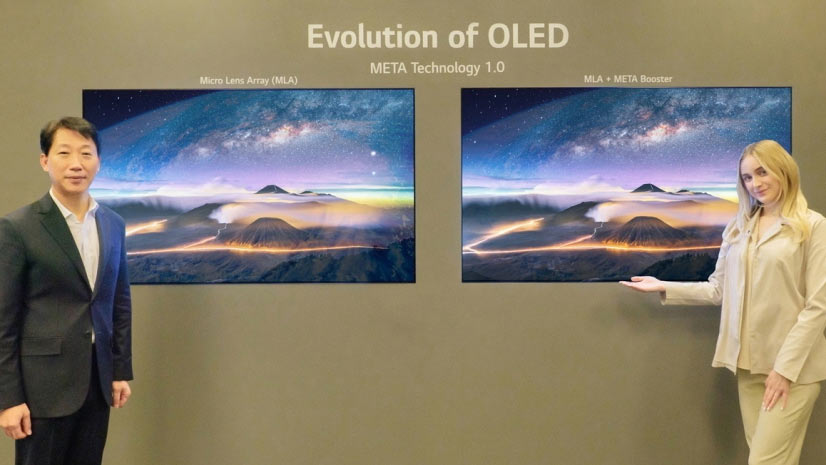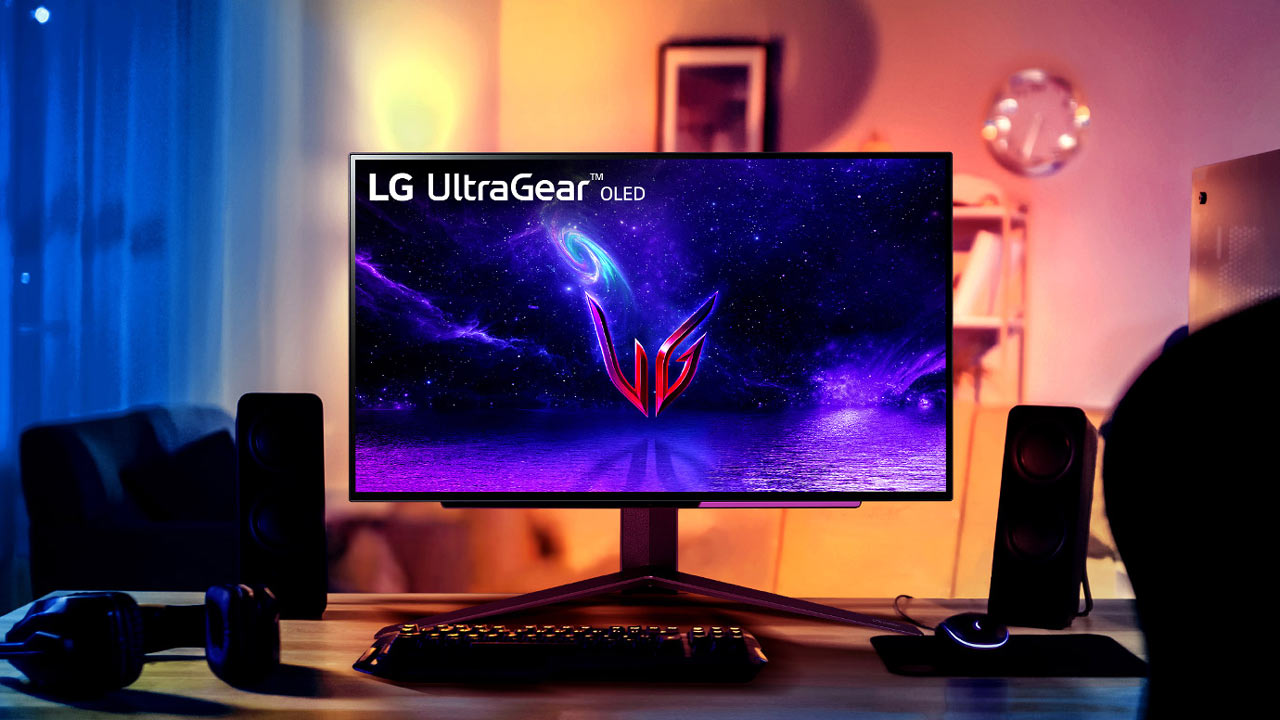LG Releases OLED Monitor Inspired by Dragonfly Eyes
There are over 5,000 micro lenses per pixel, enabling up to 2,100 nits and 160 degree viewing angles.
LG and partners are preparing to release gaming monitors featuring third-generation OLED panels, later this month. This is gratifying to see, as LG launched the new OLED panels, based on its latest Meta technology, with reference made only to the home TV market, during the recent CES 2023 expo.
The key claimed attractions of LG META technology OLED panels are that they offer “60 percent brighter images and 30 percent wider viewing angles than conventional OLED displays.” This is largely the result of the use of a ‘Micro Lens Array’ (MLA) inspired by the structure of dragonfly eyes. In practice, the MLA maximizes light emission from the OLED panel, and then LG applies a ‘META Booster,’ brightness-enhancing algorithm.
Thankfully, LG provided some performance stats for its new Meta technology monitors, to put their value into some perspective. When it launched the technology for TVs it said the new displays will hit up to 2,100 nits of brightness. Combined with the inherent deep blacks of OLED panels, this is going to make for some extremely punchy contrast stats.
The number of micro lenses used by LG’s third-gen OLED (or Meta) displays to boost the maximum brightness and viewing angles of the panels is mind-boggling. According to the company, every pixel of a Meta OLED screen is accompanied by 5,117 micro lenses. In its 77-inch 4K OLED TV, showcased at CES 2023, this means that there were over 42 billion micro lenses in the display.
OLED-Info reports that LG will be applying MLA technology to gaming monitors, too. Two monitors are known to feature the newest gen OLED panels with MLA: the LG UltraGear 27GR95QE-B or the Asus ROG Swift PG27AQDM. We previously reported upon these monitors, before it was established exactly what display panel would be used be the shipping hardware.
The LG model is currently up for pre-order at $999, but if you click through it is actually ready to ship. Asus’ monitor is expected to become available sometime in the current quarter. We will see if these monitors are really good enough to join the ranks of our Best Gaming Monitors 2023 picks, in due course.
Get Tom's Hardware's best news and in-depth reviews, straight to your inbox.

Mark Tyson is a news editor at Tom's Hardware. He enjoys covering the full breadth of PC tech; from business and semiconductor design to products approaching the edge of reason.
-
bit_user ReplyWhen it launched the technology for TVs it said the new displays will hit up to 2,100 nits of brightness.
Oh dear. I'm afraid I'd probably have to start wearing sunglasses just to watch TV. I already turn down my PC monitors below their default contrast setting.
Bright light is painful to my aging eyes. Or maybe I just got nibbled by a vampire, at some point?
But I sure do like the idea of those inky deep blacks!
every pixel of a Meta OLED screen is accompanied by 5,117 micro lenses.
So, one must wonder if these are truly precision-shaped lenses, or basically just a rough surface like the anti-glare coating you see on some conventional monitors.
My guess is that they probably employed a chemical technique for etching the material at the desired granularity. That's not to say it's not good - just that it's probably not as if they're using some lithographic technique to shape each and every one of those lenses, individually. -
Kamen Rider Blade Reply
That 2100 nits is probably peak brightness in a 10% window, not the overall screen brightness if you have to turn the entire display up.bit_user said:Oh dear. I'm afraid I'd probably have to start wearing sunglasses just to watch TV. I already turn down my PC monitors below their default contrast setting.
Bright light is painful to my aging eyes. Or maybe I just got nibbled by a vampire, at some point?
But I sure do like the idea of those inky deep blacks!
So, one must wonder if these are truly precision-shaped lenses, or basically just a rough surface like the anti-glare coating you see on some conventional monitors.
It's probably a rough surface like the anti-glare coating.
My guess is that they probably employed a chemical technique for etching the material at the desired granularity. That's not to say it's not good - just that it's probably not as if they're using some lithographic technique to shape each and every one of those lenses, individually.
I doubt they would spend that much fab time etching things with that level of granularity, that isn't cost effective. -
tennis2 Reply
Probably even less than that.Kamen Rider Blade said:That 2100 nits is probably peak brightness in a 10% window, not the overall screen brightness if you have to turn the entire display up.
And while nobody needs their retinas burned out by 2000nits, it at least should translate into a lessened rate of panel degradation and burn-in. -
Kamen Rider Blade Reply
I don't trust any of their marketing claims, I'll wait until detailed testing reports comes in to validate any of their marketing.tennis2 said:Probably even less than that.
And while nobody needs their retinas burned out by 2000nits, it at least should translate into a lessened rate of panel degradation and burn-in. -
Metteec If viewing an OLED monitor in mildly lit room, anything over 1,000 nits will cause the eyes' iris to contract, making the difference imperceptible; you will see the same blinding light at 1,000 nits or 10,000 nits. In a well-lit room, however, 2,000 nits could create superior contrast to other panels. Hopefully Toms can get their panda paws on this one to do some real testing for the rest of us.Reply -
DougMcC I'm a little curious, are you restricted in how you clean the surface to avoid damaging the tiny lenses, or is there a flat layer over them that is safe to clean?Reply -
4Forethought Reply
It appears to be a coating over each individual OLED. There will be a protective anti-glare layer over the OLED array.DougMcC said:I'm a little curious, are you restricted in how you clean the surface to avoid damaging the tiny lenses, or is there a flat layer over them that is safe to clean? -
edzieba Reply
5117 lenses per pixel for a 77" UHD panelbit_user said:So, one must wonder if these are truly precision-shaped lenses, or basically just a rough surface like the anti-glare coating you see on some conventional monitors.
My guess is that they probably employed a chemical technique for etching the material at the desired granularity. That's not to say it's not good - just that it's probably not as if they're using some lithographic technique to shape each and every one of those lenses, individually.
1705mm / 3840 = 0.44mm/pixel
440um^2 / 5117 = 38 um^2 per lensFor comparison, a BD pit is around 0.014um^2, and BDs are reliably reproducible by mechanical stamping. That means an individual microlens is around 2700 times coarser than a feature reproducible by slapping some warm plastic with a metal mould. Since the microlenses do not need to be perfectly aligned with the underlying pixel grid of the OLED substrate, I can see these microlenses being easily formed by mechanical moulding rather than requiring any photolithography. -
bit_user Reply
Mechanically stamping something that large would seem to be problematic, or at least a good deal more tricky than a thin 5" disc of metal foil.edzieba said:I can see these microlenses being easily formed by mechanical moulding rather than requiring any photolithography. -
derekullo This brightness mode is for SD content.Reply
This brightness mode is for HD content.
This brightness mode is for 4K content.
This brightness mode is for tanning!

